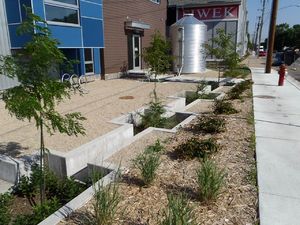
Difference between revisions of "Stormwater and rainwater harvest and use/reuse"
m |
m |
||
| Line 27: | Line 27: | ||
*[[Cost-benefit considerations for stormwater and rainwater harvest and use/reuse]] | *[[Cost-benefit considerations for stormwater and rainwater harvest and use/reuse]] | ||
*[[Case studies for stormwater and rainwater harvest and use/reuse]] | *[[Case studies for stormwater and rainwater harvest and use/reuse]] | ||
| − | *[[Minnesota reuse | + | *[[Minnesota reuse projects]] |
*[[Calculating credits for stormwater and rainwater harvest and use/reuse]] | *[[Calculating credits for stormwater and rainwater harvest and use/reuse]] | ||
*[[Photo gallery for stormwater and rainwater harvest and use/reuse]] | *[[Photo gallery for stormwater and rainwater harvest and use/reuse]] | ||
Revision as of 21:08, 14 May 2021
Information: There is currently an interagency effort to advance safe and sustainable reuse in Minnesota. The Clean Water Fund Water Reuse project consists of a group of state agencies and other interested parties that are working towards clarifying the regulatory pathway for water reuse and evaluating resources needed for successful implementation of water reuse. Learn more about this Clean Water Fund project, sign up for project updates, and find the group's meeting schedule and opportunities for input at the project website.
Green Infrastructure: Stormwater and rainwater harvest and use systems can improve or maintain watershed hydrology, reduce pollutant loading to receiving waters, increase water conservation, reduce stress on existing infrastructure, and reduce energy consumption

Check out this nice story about a rainwater harvest system at a coffee shop in St. Paul.
Rain water harvesting is the practice of collecting rain water from impermeable surfaces, such as rooftops, and storing for future use.
View the following pages as a single article
- Overview for stormwater and rainwater harvest and use/reuse
- Design criteria for stormwater and rainwater harvest and use/reuse
- Construction specifications for stormwater and rainwater harvest and use/reuse
- Operation and maintenance for stormwater and rainwater harvest and use/reuse
- Water quality considerations for stormwater and rainwater harvest and use/reuse
- Environmental concerns for stormwater and rainwater harvest and use/reuse
- Cost-benefit considerations for stormwater and rainwater harvest and use/reuse
- Case studies for stormwater and rainwater harvest and use/reuse
- Minnesota reuse projects
- Calculating credits for stormwater and rainwater harvest and use/reuse
- Photo gallery for stormwater and rainwater harvest and use/reuse
- Definitions for stormwater and rainwater harvest and use/reuse
- Requirements, recommendations and information for using Harvest and re-use/cistern as a BMP in the MIDS calculator
- Links for stormwater and rainwater harvest and use/reuse
- References for stormwater and rainwater harvest and use/reuse
- Technical support for stormwater and rainwater harvest and use/reuse
- Stormwater reuse for irrigation - preliminary modeling analysis

